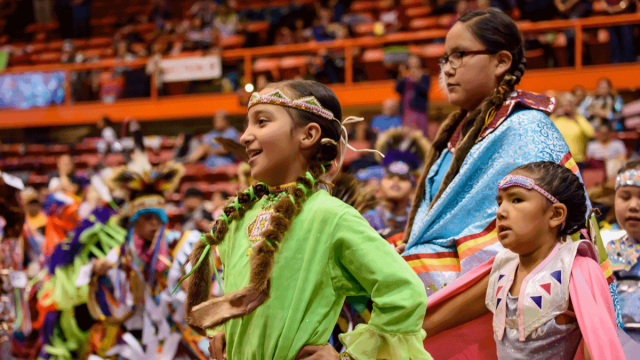These historical sites, museums, and cultural centers are the perfect way for families to learn more about Native American culture
It’s Native American Heritage Month every November and while learning about Native culture shouldn’t be restricted to a month every year, it’s certainly a time to spotlight the many Native American communities and their rich histories. This is a time to focus on their diverse heritage and important contributions and learn as much as we can as well as teach our children to respect and celebrate the Native American communities that have always called these lands their home. Here are a few venues where you can do that responsibly, and the kids can benefit from an immersive educational experience that aids their learning as well.
Knife River Indian Villages National Historic Site | North Dakota
Knife River Village was last occupied in 1845 by the Hidatsa and Mandan, and the national historic site is home to a beautiful state‐of‐the‐art museum and interpretive center dedicated to preserving their culture. Today, you can explore the museum on the site, which is filled with Mandan artifacts and art created by Plains artists, and then take a walking tour of the village remains.
Kids will love: The historic site also has a junior ranger program, where kids can explore the historical aspects of the village site and earn badges when they complete the program.
Online: nps.gov
Related: 13 Children’s Books That Celebrate Native American Cultures & Authors
Indian Pueblo Cultural Center | New Mexico
Native Americans have inhabited the region now known as New Mexico for thousands of years, and their presence is felt throughout the state. This culture is reflected in nearly every aspect of life within Albuquerque—from the city’s art and architecture to its festivals and culinary traditions. This influence extends into the present day among New Mexico’s 23 Native American pueblos, tribes, and nations, ensuring this way of life continues to endure.
Kids will love: Kids can meet artists selling handcrafted works, experience dance performances and lessons, and savor unique contemporary Indigenous meals at the on-site full-service Indian Pueblo Kitchen restaurant.
Online: indianpueblo.org
Heard Museum | Arizona
With a vast collection of southwest Indigenous people's art, history, artifacts, clothing tools, and more, the Heart Museum features one exhibit called Away From Home: American Indian Boarding School Stories telling the significant and often untold period of American history in the 1870s where American Indians were forced to assimilate into government-operated boarding schools. The newest exhibit called Substance of Stars combines digital technology with contemporary art from Haudenosaunee, Yup’ik, Diné, and Akimel O’otham Tribes.
Kids will love: Hands-on galleries offer interactive fun and many cultural learning opportunities for kids. Heard hosts the Hoop Dancing World Championships annually slated for February 18-19, 2023.
Online: heard.org/boardingschool
Powwows | South Dakota
South Dakota is home to famed sites like Mount Rushmore National Memorial and the Old West town of Historic Deadwood, along with vast outdoor adventures, and Native American heritage. The state’s tribal nations visitor guide features a map of tribal lands, a brief history of each tribe, visitor etiquette suggestions, and destinations that provide opportunities to learn more about each tribe.
Kids will love: Powwows are one of the best ways to see Native American culture up close. Kids can learn cultural etiquette and how to participate in support of Native American tribes.
Online: travelsouthdakota.com
Carpinteria State Beach | California
Carpinteria State Beach is on the ancestral land of the Chumash people in an area they called Mishopshnow, meaning “correspondence,” because it was a center of trade. The Spanish explorers called it Carpinteria because it was where the Chumash crafted their tomol canoes sealed with tar and pitch. Today you can still find tar seeping from rocks within the park. The Chumash Painted Cave can be visited along the way, which is a small painted rock on the hillside of a rural two-lane mountain road near Santa Barbara, featuring an interpretive panel for the archaeological site.
Kids will love: The Junior Ranger programs, self-guided explore packs, visitor center exhibits and the Tomol Interpretive Play along the accessible interpretive trail which runs between Linden Avenue and the park’s entrance.
Online: parks.ca.gov
Denver Art Museum | Colorado
Beginning around 1925, the Denver Art Museum was among the first U.S. museums to recognize the beauty and value of Indigenous arts and start a collection. Today, it is home to more than 18,000 objects by artists from more than 250 Indigenous nations. The collection includes ancient ceramics, beaded garments, and carved masks, plus contemporary paintings, sculptures, photography, and more from artists across North America.
Kids will love: Family Central, an immersive experience with costumes, wood blocks, and more to create with. Kids can contribute to an art project about Denver in the Native Arts Artist-in-Residence Studio.
Online: denverartmuseum.org
This Is The Place Heritage Park | Utah
The Native American Village here honors Utah's Native tribes through interactive cultural presentations. Natives dressed in traditional regalia tell the stories of their homes, lifestyle, and contributions to Utah's heritage. The quiet beat of a drum and Native songs tell the story of the ancients. See the largest teepee in America as well as an authentic Navajo Hogan and learn the story of the Medicine Wheel, sometimes known as the Sacred Hoop.
Kids will love: There is craft-making at the Village and kids learn about designs and symbols called petroglyphs that the ancients carved into rocks. There are rock-type features to climb on and a stream to float wooden boats in.
Online: thisistheplace.org
